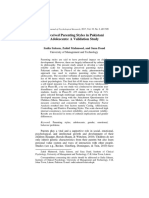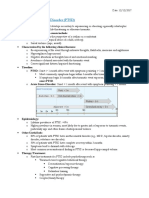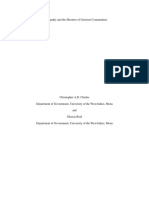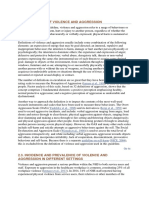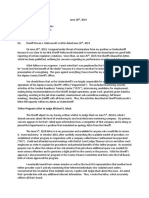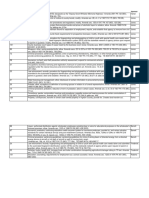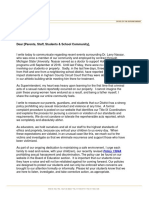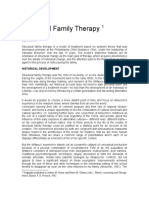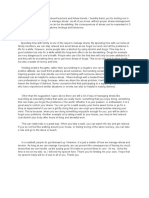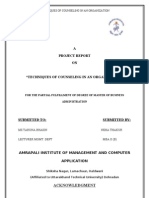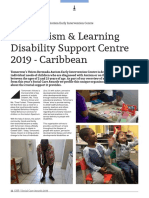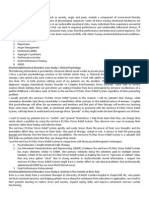Michigan Corrections Organization PTSD Study
Michigan Corrections Organization PTSD Study
Uploaded by
Justin HinkleyCopyright:
Available Formats
Michigan Corrections Organization PTSD Study
Michigan Corrections Organization PTSD Study
Uploaded by
Justin HinkleyOriginal Title
Copyright
Available Formats
Share this document
Did you find this document useful?
Is this content inappropriate?
Copyright:
Available Formats
Michigan Corrections Organization PTSD Study
Michigan Corrections Organization PTSD Study
Uploaded by
Justin HinkleyCopyright:
Available Formats
1
Prevalence of Trauma-related Health Conditions in Correctional Officers:
A Profile of Michigan Corrections Organization Members
Prepared by
Michael D. Denhof, PhD and Caterina G. Spinaris, PhD
of Michael D. Denhof LLC and Desert Waters Correctional Outreach
DESERTWATERS.com
MIKEDENHOF.com
2016
Executive Summary
A formal research inquiry was performed into the prevalence of various health
status conditions among Michigan Corrections Organization (MCO) members,
primarily white male Corrections Officers, working in prison environments. The
relationship between magnitude of exposure to work-related events involving
violence, injury and death (VID), and several health conditions was examined.
Differences in rates based on Security Level, Gender, Military status, and Years
Corrections Experience were also explored. Using established and psychometrically
sound assessment instruments, rates of Post-traumatic Stress Disorder,
Depression, Co-occurring Post-traumatic Stress Disorder and Depression, and
Suicide Risk were estimated. Health condition rates were found to be substantially
elevated relative to rates typical in the general population and for other public
safety professions. Statistically significant relationships were found between level of
work-related exposure to violence, injury, and death (VID) events and mental
health condition scores. Security Level and Years of Corrections Experience were
found to moderate health condition rates significantly, with more years of
corrections experience and higher security levels being associated with higher
mental health condition rates. Pre-corrections Military Experience and Gender
demonstrated little to no effect upon mental health condition rates. These findings
reinforce a growing perspective among researchers that Corrections Officers suffer
health detriments due to high stress and potentially traumatic occupational
experiences comparable to those more widely known to occur for police officers,
firefighters, and combat military personnel.
INTRODUCTION
In the course of performing their work duties, corrections staff are often
exposed, directly and indirectly, to incidents involving violence, injury or death
(Bureau of Labor Statistics, 2015; Konda, Tiesman, Reichard, & Hartley, 2013;
Schlosser, Safran, & Sbarratta, 2010; Spinaris, Denhof & Kellaway, 2012). Common
examples include being physically assaulted, encountering dead or mutilated
bodies, witnessing attempted or completed suicides, being threatened with physical
harm or death, witnessing assaults, riots, or arson, or learning about, second hand,
any of the above, on a fairly recurrent basis.
Direct exposure to events involving violence injury, or death (VID), as well as
repetitive indirect exposure as part of ones job role, can have cumulative and
deleterious effects upon the health and functioning of corrections workforce cultures
and their staff member constituents (American Psychiatric Association, 2013;
Bureau of Labor Statistics, 2015; Denhof & Spinaris, 2013; Denhof, Morton &
Spinaris, 2014; Konda et al., 2013; Spinaris et al., 2012; Stadnyk, 2003).
While corrections work has not received the extent of research attention as
other similar job roles, it remains the case that corrections staff are exposed to
many of the same types of work-related traumatic events as are police officers
(Perrin et al., 2007), firefighters (Corneil, Beaton, Murphy, Johnson, & Pike, 1999),
combat military personnel (Fulton et al., 2015; Gates et al., 2012), and other law
enforcement positions (Bureau of Labor Statistics, 2015).
For example, Spinaris et al. (2012) reported that United States corrections
professionals experience an average of 28 exposures to VID events and involving
events of five different types, on average. As another example, Bureau of Labor
Statistics (2015), correctional officers and jailers, in 2014, sustained 53.5 workrelated intentional injuries by another person per 10,000 FTEsa. This is much higher
than the equivalent rate for all types of workers (2.9 per 10,000 FTEs), and even
higher than that for police and sheriffs patrol officers (42.5 per 10,000 FTEs).
An FTE represents the equivalent of hours worked by one full-time employee.
From 1999 to 2008, there were 113 confirmed work-related fatalities among
corrections officers (COs)a rate of 2.7 per 100,000 FTEs (Konda et al., 2013),
25% of which were found to be due to homicides. Of the non-fatal work-related
injuries due to assaults and violent acts, 37% were found to occur while restraining
or otherwise interacting with an inmate during an altercation.
Given the high levels of exposure to VID events suffered by corrections staff, it
logically follows, and would seem plausible, that this population would also face
similarly elevated rates of stress-related health conditions, such as post-traumatic
stress disorder (PTSD) and/or depression. Several recent studies do, in fact,
support a linkage between VID event exposure and corrections professionals
mental and physical health status of various types (Denhof & Spinaris, 2013;
Spinaris et al., 2012; Stadnyk, 2003), such that more exposure is frequently
associated with decreased health status.
This relationship has been found to hold particularly true for COs, who tend to
play the most front line and high exposure work roles in corrections environments
(Denhof & Spinaris, 2013; Obidoa, Reeves, Warren, & 2011; Spinaris et al., 2012;
Stadnyk, 2003). To illustrate, researchers have discovered that, within a given
correctional staff population, a substantial percentage of COs demonstrate
moderate to severe levels of depression, stress, or anxiety disorder symptoms at a
higher rate than corrections professionals with different job roles (Denhof &
Spinaris, 2013).
In the most severe cases, full criteria for mental health conditions such as Major
Depressive Disorder (Obidoa et al., 2011; Denhof & Spinaris, 2013; Samak, 2003),
PTSD (Spinaris et al., 2012; Stadnyk, 2003), or comorbid (i.e., concurrent)
conditions (Denhof & Spinaris, 2013) are potentially met. Evidence of deleterious
effects of corrections work and VID event exposure upon physical health, such as
high blood pressure, digestive disorders, sleep difficulties, and memory impairment,
have been documented as well (Denhof & Spinaris, 2013; Morse, Dussetschleger,
Warren, & Cherniack, 2011; Spinaris et al., 2012).
A noteworthy and recent development in the latest (fifth) iteration of the
Diagnostic and Statistical Manual of Mental Disorders (DSM-5; American Psychiatric
Association, 2013), is that the definition of what constitutes PTSD-related traumatic
exposure was expanded to include not only direct exposure, but also cases of
indirect exposure that are repetitive or extreme, and occur as part of ones work
role. This expansion of the definition of traumatic exposure makes clear that the
events COs are routinely exposed to, whether directly or indirectly, do, in fact,
constitute potentially traumatic events.
While a variety of health-related consequences have been linked to traumatic
exposure in corrections settings, Denhof and Spinaris (2013) have highlighted that
the presence of comorbid depression and PTSD appears to be particularly
consequential compared to either depression or PTSD. They showed that
corrections staff with comorbid status demonstrated significantly worse scores on a
spectrum of related negative health conditions and measures of life functioning
than did corrections staff with either PTSD or depressionb alone.
Related studies of military personnel, 9/11 clean-up crews, and other groups
(Campbell et al., 2007; Cukor et al., 2011; Dobie et al., 2006; Erickson, Wolfe,
King, King, & Sharkansky, 2001; Oquendo et al., 2005; Shalev et al., 1998) have
estimated comorbidity levels ranging from 30-75%, depending on the population.
These high rates are particularly important, as both PTSD and depression have
been found to be independently associated with suicidal behavior, and their
combination even more strongly associated with suicidal behavior (Davidson,
Hughes, Blazer, & George, 1991; Freeman, Roca & Moore, 2000; Marshall et al.,
2001; Oquendo et al., 2003; Sareen et al., 2005; Sareen et al., 2007).
The main purpose of the present study was to estimate the prevalence of
PTSD, depression, PTSD and depression comorbidity, suicide risk, and levels of
exposure to violence, injury and death (VID) events among members of the
Michigan Corrections Organization (MCO), primarily COs, using psychometrically
sound clinical assessment instruments. A secondary purpose of the study was to
highlight the relationship between VID event exposure and mental health status,
and to help demonstrate that the widely acknowledged relationship between trauma
b
Depression was operationally defined as cases of Moderate to Severe Depression Symptom Severity based
DASS-21s Depression scale total scores or 14 and above (Henry & Crawford, 2005; Lovibond & Lovibond, 1995).
and disorder for combat military personnel, police officers, and other high stress
occupations, applies similarly in corrections work. Additional comparisons were
made based on demographic variables of Gender, Prior Military Status, and Years of
Corrections Work.
METHOD
A web-hosted clinical assessment battery was administered to MCO members,
consisting of COs and Forensic Security Assistants, primarily white (84%) males
(81.3%), working in a prison setting (95.5%). See Appendix A for full demographic
and participant characteristic statistics. For the sake of simplicity, all participants
will be referred to in this paper as COs.
Voluntary participation was advertised to members in multiple ways, including
through an organization newsletter, facility bulletin board postings by Chapter
presidents, and direct emails to approximately 3400 COs.
Using a provided password, participants accessed a set of self-administrable
online assessment instruments by internet or smartphone. Participation was
anonymous and did not require provision of identifying information. Anonymous
participation was considered important as it has been the experience of this studys
researchers that corrections staff populations tend to be particularly apprehensive
about the possibility of their employer becoming privy to their assessment results.
All participants were required to read and agree to an informed consent form that
described the nature, details, and risks involved in participation.
Participation consisted of responding to lists of either statements or questions
that comprise various psychometrically sound clinical assessment tools, including
the Post-traumatic Checklist Version 5 (PCL-5, Weathers et al., 2013), the Patient
Health Questionnaire (PHQ-9, Spitzer, Kroenke, & Williams, 1999; Kroenke, Spitzer
& Williams, 2001), the Violence, Injury, and Death Exposure Scale (VIDES, Denhof
& Spinaris, 2014), and the Depression Danger Scale (DDS, Denhof, 2014).
The format of responding required each participant to choose a best answer
from among sets of multiple choice scaled-response options, such as: FALSE,
SLIGHTLY TRUE, MOSTLY TRUE, VERY TRUE. Response options varied from
instrument to instrument, but had a similar structure.
Among 1295 members who began the online survey, 304 discontinued
prematurely and their incomplete data were discarded. Ultimately 991 members
participated fully, providing complete data and a substantial total sample size for
analysis and representation of the MCO member population.
Analysis of data from the 991 participants fully completed assessments
provided the basis for estimating the prevalence of PTSD status (positive/negative),
Depression status (positive/negative)c, different levels of exposure to VID events
occurring in the corrections workplace, and elevated suicide risk. See Appendix B
for supplemental information on the nature and psychometric properties of clinical
assessment instruments used for estimation in this study.
Depression Positive was defined as a PHQ-9 total score falling into the Moderate Depression interpretive
category, based on a PHQ-9 score of 10 or higher.
RESULTS
Violence, Injury, and Death Event Exposure for Corrections Staff
The level of exposure to violence, injury and death events among staff was
assessed using the VIDES. Results indicated that a substantial percentage (68.7%)
of participating COs are subject to Moderate to Extreme levels of exposure. The
chart in Figure 1 indicates the percentage of COs who scored in four different
categories of exposure magnitude.
Level of VID Exposure (%)
35
30
31.3
27.6
25
22.5
18.6
20
15
10
5
0
Extreme
High
Moderate
None to Minimal
_________________________________________________
Figure 1. Percent VID Event Exposure Levels for Corrections Officers
The strength of relationships between traumatic exposure and various mental
health conditions was assessed through Pearson correlations. Substantial and
statistically significant correlations were found between the VIDES total score and
total scores from the PHQ-9, DDS, PCL-5, and each of the PCL-5s individual
symptom clusters. As illustrated in Figure 2, correlations with the VIDES total score
ranged from r=.33 to .45. All correlations were found to be statistically significant
at p<.01, N=991.
10
Strength of Relationship to the VIDES Total Score
PCL-5 Total Score
0.45
Symptom Cluster E
0.43
PHQ-9 Total Score
0.40
Symptom Cluster D
0.39
DDS Total Score
0.36
Symptom Cluster C
0.34
Symptom Cluster B
0.33
0.00
0.10
0.20
0.30
0.40
0.50
________________________________________________
Figure 2. VIDES Correlations to Multiple Health Status Indicators
Note: PCL-5 Cluster E represents alterations in arousal and reactivity; PCL-5
Cluster D represents negative alterations in cognitions and mood; PCL-5 Cluster
C represents avoidance (of distressing stimuli associated with a traumatic
event); and PCL-5 Cluster B represents intrusion symptoms (i.e., involuntary and
distressing re-experiencing of aspects of a traumatic event).
To assess the relationship between VID exposure and security level of
participating CO work environments, mean VIDES total scores were plotted across
four security levelsd. The plot shown in Figure 3 reveals an upward trend, where
higher security levels are accompanied by higher levels of VID exposure. The
difference between security levels one and two, and between levels four and five,
was relatively small compared to the difference between levels two and four.
Levels one and two, and levels four and five were collapsed to produce Low and
High Security subgroups for remaining analyses. This was done for the benefit of
simplifying illustrations and to permit calculation of relative risk ratios that require 2
x 2 contingency tables. The VIDES mean total scores for COs in High (M=4.28,
SD=1.43) versus Low (M=3.51, SD=1.49) Security subgroups were confirmed to
differ to a statistically significant degree (t=8.09, df=947, p<.000).
Note: Within the population sampled, there were 4 security levels: 1, 2, 4, and 5. No level 3 exists.
11
Average VIDES Score by Security Level
4.4
4.2
4.0
3.8
3.6
3.4
3.2
3.0
Level 1
Level 2
Level 4
Level 5
__________________________________________________________________
Figure 3. Average VIDES Exposure Levels for Corrections Officers by Security Level
Mental Health Condition Prevalence Overall and
by Low vs. High Security Levels
PTSD
The prevalence of PTSD within CO participants was estimated using the PCL5 and the symptom cluster method, which aligns with the criteria for diagnosing
PTSD as defined in the DSM-5. Under this method, individuals need to concurrently
meet one or more Cluster B criteria, one or more Cluster C criteria, two or more
Cluster D criteria, and two or more Cluster E criteria.
It was found that 33.7% of COs were estimated to be PTSD Positive, and 4364% met criteria for individual diagnostic symptom clusters, as illustrated in Figure
4. Comparing estimated rates within High and Low Security subgroups revealed
that COs working in high security areas met criteria for PTSD at a substantially
higher rate than those working in low security areas. COs in the High Security
subgroup showed a PTSD Positive rate of 39.3% while COs in the Low Security
12
subgroup showed a PTSD Positive rate of 28.8%. The difference in proportions of
PTSD Positive to PTSD Negative cases, across security levels, was found to be
statistically significant (
=11.65, df=1, p<.000).
A relative risk ratio statistic was generated to convey the effect size. COs
working in high security areas were found to be at 37% greater risk of PTSD
Positive status than were COs working in low security areas, RR=1.37, 95% CI
[1.14-1.63].
Estimated PTSD Prevalence (%)-All
Percentage Meeting Symptom
Cluster Criteria-All (%)
Cluster E
33.7
64
Cluster D
56.7
Cluster B
51.7
Cluster C
PTSD Positive
43.2
20
40
60
80
PTSD Positive by Security Level (%)
Security Low
28.8
Security High
39.3
10
20
30
40
50
_________________________________________________________________________
Figure 4. PTSD and Symptom Cluster Prevalence for All COs and Security Level Subgroups
Depression
The prevalence of Depression was estimated by defining Depression Positive in
terms of PHQ-9 scores falling in the Moderate Depression (or higher) range. Pie
charts in Figure 5 indicate the percentage of COs falling into each of several PHQ-9
13
depression level categories, as well as the percentage estimated to be Depression
Positive.
As indicated in Figure 5, the prevalence of Depression Positive cases for all COs
was found to be 36.3%. The rates for High and Low Security subgroups were
41.8% and 31.5%, respectively, reflecting a statistically significant difference
between groups (
=11.01, df=1, p=.001). Calculation of relative risk indicated
that COs in the High Security subgroup were at 33% greater risk of Depression
Positive status than COs in the Low Security subgroup, RR=1.33, CI [1.12-1.58].
Depression Levels (%)-All
Depression Positive (%)-All
Severe, 9.0
Mod. Severe,
11.7
Moderate, 15.6
36.3
None to
Mild,
63.6
Depression+
Depression Positive by
Security Level (%)
Low Security
31.5
High Security
41.8
10
20
30
40
50
______________________________________________________________
Figure 5. Depression Prevalence among All COs and Security Level Subgroups
Comorbidity
Comorbid Positive status was defined as cases where a CO was estimated to be
concurrently PTSD Positive and Depression Positive. The prevalence of COs who
14
met criteria for both PTSD Positive and Depression Positive was found to be 24.9%.
The prevalence of Comorbid Positive status for COs in High and Low Security level
subgroups was 30.7% and 19.3%, respectively. See Figure 6 for graphic
illustrations.
The difference in Comorbid Positive rates between COs in different security level
subgroups was determined to be statistically significant (
=16.59, df=1, p=.000).
Relative risk was calculated, indicating that COs in the High Security subgroup were
at 59% greater risk of Comorbid Positive status than those in the Low Security
subgroup, RR=1.59, CI [1.27-2.00].
Comorbid Positive (%)-All
24.9
Comorbid Positive by Security
Level (%)
Low Security
19.3
High Security
Comorbid Positive
30.7
10
20
30
40
__________________________________________________________________
Figure 6. Prevalence of Comorbid PTSD and Depression among Corrections Officers
Suicide Risk
The prevalence of suicide risk was estimated using the DDS. Scores falling in the
High Risk range defined suicide risk as being substantially elevated. As indicated in
Figure 7, 4.6% of COs scored in the High Risk interpretive category, among
possible categories None, Slight, Moderate, and High.
Comparing the prevalence of High Risk scores for COs working in high versus
low security areas revealed rates of 5.8% and 3.1%, respectively. This difference in
proportions was determined to be statistically significant (
=4.05, df=1, p=.04).
15
Calculation of relative risk indicated that the individuals in the High Security
subgroup were found to be at 87% more likely to score in the High suicide risk
category, compared to individuals in the Low Security subgroup, RR=1.87, CI
[1.01-3.46].
Highly Elevated Suicide Risk (%)-All
4.6
Highly Elevated Suicide Risk by
Security Level (%)
Low Security
3.1
High Security
5.8
0
_______________________________________________________________________
Figure 7. Estimated Percentage of Highly Elevated Corrections Officer Suicide Risk Cases
Gender Differences for Corrections Staff
To illuminate the potential influence of gender on mental health condition
prevalence, rates of PTSD Positive, Depression Positive, Comorbid Positive, and
Highly Elevated suicide risk were plotted by gender subgroups. As can be seen in
Figure 8, rates were fairly similar though male COs most often tended to score
slightly higher than females, and with the largest differences occurring for suicide
risk and PTSD status.
The proportion of positive versus negative cases was compared across Gender
subgroups to determine whether differences were large enough to be statistically
significant. Given multiple comparisons, a Bonferroni correction was implemented
to reduce the chances of increased Type I error (i.e., false positives). Thus the
default p-value of .05 was reduced to .0125 for each of multiple comparisons. Using
this approach, no statistically significant differences were found, although the precorrected p-value for suicide risk did approach statistical significance (
df=1, p=.075).
=3.16,
16
Health Condition Prevalence by Gender (%)
40
35
Percent (%)
30
25
20
15
10
5
0
Males
Females
PHQ-9
PCL-5
Comorbid
DDS
36
34.5
25.2
5.2
37.8
30.3
23.8
2.2
_______________________________________________________________
Figure 8. Health Condition Prevalence for Male and Female Corrections Officers
Prior Military Experience
To illuminate the potential influence of prior military experience, mental health
condition rates were compared for subgroups of COs who reported having or not
having prior military experience. As can be seen in Figure 9, health condition rates
were quite close across subgroups, with the biggest difference occurring for cases
of High Suicide Risk. Individuals who reported pre-corrections military service
demonstrated a slightly higher rate of elevated suicide risk (6.5%), compared to
non-military (4%).
The observed differences were assessed for potential statistical significance
using a Bonferroni-corrected p-value (.0125) criterion. None of the differences were
found to be statistically significant.
Years of Corrections Work Experience
To illuminate the potential influence of accrued years of corrections work,
mental health condition rates were compared for subgroups of COs with less than
17
Health Condition Prevalence by Military Status (%)
40
35
Percent (%)
30
25
20
15
10
5
0
PHQ-9
PCL-5
Comorbid
DDS
Military
36.8
34
25.1
6.5
Non-Military
36.2
33.6
24.9
_____________________________________________________________________
Figure 9. Health Condition Prevalence for Military and Non-Military Corrections Officers
or equal to 10 years experience versus those with more than 10 years experience.
As shown in Figure 10, there was substantial variability in health condition rates
according to the number of years spent working in corrections. Individuals with
more than 10 years experience demonstrated higher rates for all health condition
measures.
Each health conditions prevalence, as reflected by status positive versus
negative, was compared across the two Years Experience subgroups. Using a
Bonferroni-corrected p-value (.0125), two health condition rate differences were
found to be statistically significant: the PTSD Positive rate (
p=.000) and the Comorbid Positive rate (
=27.25, df=1,
=7.38, df=1, p=.007). Rates for
Depression Positive and High Suicide Risk did not quite reach significance under the
more conservative corrected p-value criterion. Both of these rates, however, were
statistically significant with uncorrected p-values, at p=.03 and p=.04, respectively.
18
Health Condition Prevalence - Less Than or Equal to 10
Years vs. Greater than 10 Years Experience (%)
Percent (%)
45
40
35
30
25
20
15
10
5
0
PHQ-9
PCL-5
Comorbid
DDS
10 or less Yrs
32.7
25.1
20.8
3.1
More than 10 Yrs
39.3
40.8
28.3
5.9
__________________________________________________________
Figure 10. Health Condition Prevalence for Years Experience Subgroups
19
DISCUSSION
Violence, Injury, and Death Exposure
The data collected in this study of MCO members experiences, involving
exposure to VID events, confirmed that a large proportion of MCO COs experience
very substantial rates of VID exposure during the course of their job functions.
Study participants completed the VIDES assessment, which measures overall
exposure magnitude, based on combined information about types, frequency, and
recency of both direct and indirect exposures to work-related events involving VID.
Results indicated that more than 50% of staff had experienced high to extreme
levels of exposure.
To assess the strength of relationship between VID exposure and various health
status conditions, Pearson correlations were calculated between (1) VIDES total
scores and (2) the PHQ-9 total score (measuring depression), the DDS total score
(measuring suicide risk), the PCL-5 total score (measuring PTSD), and individual
PCL-5 symptom cluster scores B, C, D, and E, which reflect different sets of PTSD
symptoms.
The correlations between the VIDES total score and seven different health
condition scores ranged from r=.33 to .45. All correlations were found to be
statistically significant, confirming the presence of substantive and real
relationships. Not unexpectedly, and given the vast literature supporting the
relationship between traumatic exposure and PTSD, the magnitude of the
relationship between VID exposure as measured by the VIDES, and PTSD as
measured by the PCL-5, was found to be strongest (r=.45).
A comparison of mean VIDES score differences for COs working in Low Security
and High Security subgroups was completed to discern an expected difference in
average VID exposure levels. Means for COs working in High and Low Security
areas were found to be significantly different, confirming the expectation that COs
working in high security areas would experience a higher magnitude of VID events
compared to those working in low security areas.
20
Estimated Mental Health Condition Rates
Of primary interest in this study was estimation of mental health condition rates
for COs, with the expectation, based on previous research, that they experience
various health detriments, including especially PTSD and Depression, due to the
high stress nature of the jobin a way similar to other public safety occupations
that are more widely known for their health-related occupational hazards. Of
secondary interest was demonstration of a moderating effect of VID exposure upon
mental health condition rates for High versus Low Security COs.
PTSD
The prevalence of PTSD among MCO member participants was estimated using
the latest iteration of the Post-traumatic Checklist (PCL-5)a widely used PTSD
assessment/screening toolrecently updated to align with the most recent
diagnostic criteria published in the DSM-5. Results from the PCL-5 also confirmed
the percentage of case in which criteria were met for particular PCL-5 symptom
clusters.
The overall PTSD rate was estimated to be 33.7%, far exceeding the rate that is
typical in the general population (Kessler et al., 2005), and also exceeding, but to a
lesser degree, rates published for other public safety jobs involving high exposure
to traumatic events, such as police officers, firefighters, and combat military
(Corneil et al., 1999; Fulton et al., 2015; Gates et al., 2012; Perrin et al., 2007).
The PTSD Positive rate found in this study is virtually identical to that reported for
correctional security/custody staff (34.1%), in a large sample study (N=3,599) of
corrections staff working in numerous states (Denhof and Spinaris, 2013).
The percentages of cases where criteria were met for specific diagnostic
symptom clusters was substantial, ranging from 43.2% to 64% across the four
clusters assessed by the PCL-5: B, C, D and E. Diagnostic cluster E was met at the
highest rate, of 64%, suggesting that Cluster E symptoms, involving alterations in
arousal and reactivity, are a primary issue of concern for COs. According to the
DSM-5, Cluster E reflects increased behavioral tendencies in areas including
irritable behavior, angry outbursts, reckless or self-destructive behavior,
21
hypervigilance, exaggerated startle response, problems with concentration, and
sleep disturbance. Several of these characteristics, including especially issues of
anger and sleep difficulty, have been documented previously for their prevalence
among COs (Spinaris et al., 2012).
The second most frequently met symptom cluster criterion was cluster D
(56.7%), which reflects alterations in cognition and mood. According to the DSM-5 ,
Cluster D is exemplified by impaired recall of traumatic events, negatively skewed
perspective and expectations, exaggerated sense of blame upon self or others for
traumatic events or their consequences, trauma-related emotions such as fear,
horror, anger, guilt, or shame; diminished interest in previously enjoyed activities;
feelings of detachment or social isolation, and difficulty experiencing positive
emotions.
As was the case with Cluster E, many of Cluster Ds stand out attributes have
been identified previously, including: memory impairment; depression, which
includes aspects of negative outlook, diminished interest in activities previously
enjoyed, and difficulty experiencing pleasure; and emotions of fear, horror, guilt,
and shame (Spinaris et al., 2012). Thus, the symptom cluster results provided by
MCO member participants in relation to PTSD is consistent with previous research
profiling corrections staff populations.
The prevalence of PTSD was also estimated separately for MCO member
participants working in high and low security environments. MCO participants in the
High Security subgroup were confirmed for demonstrating significantly higher VID
exposure magnitude, and therefore were expected to show respectively higher
rates of negative health statuses. This expectation was supported, as COs working
in high security environments showed a significantly higher rate of PTSD Positive
(39.3%), compared to those working in low security environments (28.8%). While
participants in both High and Low Security subgroups demonstrated substantial and
concerning PTSD rates, high security COs were estimated to be at 37% greater risk
for PTSD Positive, compared to low security COs.
22
Depression
The prevalence of MCO member participants demonstrating a Moderate or
higher level of depression, based on results from the PHQ-9 depression measure,
were defined as Depression Positive. The percentage estimated to be Depression
Positive was 36.3% for all MCO member participants. This rate is slightly higher
than a previously estimated rate (31.0%) for COs nationwide (Denhof & Spinaris,
2013; Obidoa et al. 2011). The rate of 36.3% far exceeds what has been found
typical in the general population, ranging from approximately 8 to 10% (United
States Center for Disease Control and Prevention (US-CDC; 2010).
Notably, depression in the workplace has been found to be among the costliest
of health conditions. According to the World Health Organization (2012), depression
is the leading cause of disability worldwide in terms of total years lost due to
disability. Depression has been associated with reduced productivity, increased
disability claims, absenteeism (Kessler & Frank, 1997), and premature retirement
(Wang, 2004).
The rate of Depression Positive in the current study was also estimated for MCO
member participants working in low versus high security environments, which, as
discussed, manifest significantly different levels of VID event exposure. As was
found to be the case with PTSD rates, the estimated number of Depression Positive
cases was found to be significantly higher for participants constituting the High
Security subgroup (41.8%) compared to the Low Security subgroup (31.5%).
Estimation of relative risk indicated that individuals working in high security areas
were at 33% greater risk of being determined Depression Positive, compared to
those working in low security areas.
Comorbidity
The prevalence of Comorbid Depression Positive and PTSD Positive cases was
estimated. The importance of this combination has been highlighted in previous
research into the health profile characteristics of United States corrections
professionals (Denhof & Spinaris, 2013). Denhof and Spinaris reported that,
23
compared to individuals meeting criteria for either PTSD alone or Depression alone,
individuals meeting criteria for both conditions concurrently tended to also show
significantly higher scores and effect sizes across a whole spectrum of related
health status measures, including: measures of stress, anxiety, and life
satisfaction; reported number of absences from work and doctor visits; substance
use; total number of reported health conditions of various types; and reported
levels of impaired functioning in relationship, leisure time, caregiver, and personal
responsibility contexts.
The rate of Comorbidity among MCO members in the current study was
estimated to be 24.9%. Not unexpectedly, the current studys estimated
Comorbidity rate for high security COs (30.7%) was significantly higher than the
rate for low security COs (19.3%). COs in the High Security subgroup were
estimated to be at 59% greater risk of Comorbid Positive status than individuals in
the Low Security subgroup. The prevalence of Comorbid Positive status in the
current study is slightly higher and in the ballpark of Denhof and Spinaris previous
Comorbidity rate estimate of 21.9%, based on nationwide sample data from
corrections security/custody staff (Denhof & Spinaris, 2013).
Suicide Risk
The DDS was designed as a measure of both group-level and individual level
suicide risk, and validated for use with corrections staff populations (Denhof, 2014).
It consists of assessment items associated with severe depression and suicidal
behavior. The DDS provides a useful approach to monitoring staff suicide risk within
corrections workplace cultures, which is important, given the high rates of
corrections staff suicide that have been documented (New Jersey Police Suicide
Task Force Report, 2009; Stack and Tsoudis, 1997; Violanti, Robinson, & Shen,
2013).
Using the DDS, the percentage of MCO COs scoring in the High range of suicide
risk was estimated to be 4.6%. While on the face of it, a percentage like this may
seem small, when considering the seriousness and consequence of staff suicides,
the importance of even small percentages of High risk becomes clear. Stated
24
another way, if an organizations workforce has a true rate of 4.6% COs in the
highly elevated suicide risk category, this means that about 5 of every 100 staff are
at a dangerous level of risk of death by suicide.
The percentage of individuals scoring in the High Suicide Risk interpretive
category of the DDS was also calculated independently for COs working in high and
low security environments. Individuals in the High Security subgroup demonstrated
a significantly higher rate of High Suicide Risk (5.8%) and an 87% greater risk of
scoring in the High Suicide Risk category, compared to individuals in the Low
Security subgroup (3.1%).
Gender Differences for Corrections Staff
Gender differences are often reported in social science research, including
studies of corrections staff populations, out of theoretical or pragmatic interest.
Most often differences are reported in terms of statistically significant mean
differences in scores on continuous quantitative variables. However, mean
differences alone can be difficult to interpret for their practical implications
especially if interpreted without regard for whether or not clinical or diagnostic
thresholds were exceeded.
One of the advantages of the current study is that virtually all results are
presented in the form of individuals who either met or did not meet clinically
meaningful thresholds or diagnostic criteria. This approach helps reduce ambiguity
about gender differences that are just theoretically interesting versus those that
have practical consequence. For example, if male versus female subgroups of COs
were found to score, respectively, above and below, a diagnostic cut-point for a
serious condition, that difference would obviously have clear practical implications
since one group is considered disordered or manifesting a debilitating condition and
the other group is not.
In the current study of MCO COs, Gender was not found to be a particularly
important factor in relation to prevalence of deleterious mental health conditions.
Both males and females demonstrated rates of conditions that far exceeded
25
estimates of what is typical in the general population and therefore to a practically
significant extent within the corrections population. While female COs
demonstrated a pattern of slightly lower rates on most conditions measured, the
magnitudes of these differences were not statistically significant, and thus neither
real or meaningful gender differences were supported.
The general finding of minimal differences between male and female COs on key
health condition status rates, highlights how, when differences are constrained to
clinically meaningful margins or thresholds, gender differences do not always
appear. The implication here is that programs designed to address prevalent and
problematic health conditions need not be structured much differently, if at all, for
male versus female COs.
Prior Military Experience
Mental health condition rates for MCO member participants, with and without
prior military experience, were nearly identical for PTSD Positive, Depression
Positive, and Comorbidity Positive statuses, though rates tended to be slightly lower
for COs not having served previously in the military. While the percentage of COs in
the Past Military Experience subgroup did demonstrate a somewhat higher rate of
scores falling in the High Suicide Risk category of DDS results, the difference was
not found to be statistically significant.
Previous research has documented relatively small but significantly different
rates for individuals with pre-corrections military experience, where those with precorrections military activity showed an approximately 5% higher rate of Depression
Positive and a 7% higher rate of PTSD Positive cases (Denhof and Spinaris, 2013).
This prior research utilized similar but not identical estimation instruments,
however, including an older version of the Post-traumatic Checklist (PCL-C) and the
DASS-21 Depression scale (Henry, & Crawford, 2005; Lovibond & Lovibond, 1995).
While all mental health condition rate differences between COs with and without
pre-corrections military service were found to be statistically insignificant, the
pattern of slightly lower mental health condition rates for non-military COs is
26
consistent with previous findings and likely due to lifetime cumulative exposure to
VID events. It is plausible to expect that the observed differences would have been
substantively larger had the pre-corrections military service group been defined
more narrowly to include only individuals who actually engaged in combat during
their military service.
Years of Corrections Experience
While demographic variables of Gender and Pre-corrections Military Service
demonstrated little to no effect upon the various mental health conditions assessed,
one demographic variable did show a larger impactYears Experience in the field of
corrections. Large and statistically significant differences in health condition rates
were observed for COs having 10 or less years experience compared to those
having greater than 10 years experience.
Individuals with more than 10 years experience showed rates of Depression
Positive, PTSD Positive, Comorbid Positive, and High Suicide Risk level that
exceeded less experienced COs rates by 6.6, 15.7, 7.5, and 2.8 percentage points,
respectively. Two of the four rate comparisons were found to be statistically
significant after applying a more conservative Bonferonni-corrected p-value
criterionnamely, the difference in rates for PTSD Positive and Comorbid Positive.
Notably, all of the various health status comparisons across Years Experience
subgroups were statistically significant using a standard significance criterion of
p<.05.
The observed effect of Years Experience on health condition rates is plausibly
due, at least to some extent, to the impact of cumulative exposure to VID events in
the corrections setting. It has been hypothesized previously (Spinaris et al., 2012),
that corrections staff, and COs especially, may suffer an even greater toll from VID
exposure than other individuals working other law enforcement positions or combat
military roles, given the more repetitive and sustained course of exposures COs
face in their day to day routines. COs exposure to VID events take place within a
27
confined space and involving regular contact with often volatile offender
populations.
Study Limitations, Generalizability, and Implications
Generalization of results from studies utilizing convenience samples and
volunteer participation, including the current study, is always recommended with
caution. The results from the present study, however, are quite consistent with
prior and similar investigations into mental health condition rates for United States
corrections professionals (Spinaris et al., 2012; Denhof and Spinaris, 2013; Obidoa
et al. 2011).
It is prudent to highlight that the studys design incorporated the use of selfreport-based assessment instruments, which, it can be argued, are more vulnerable
to biased responding than other assessment methods, such as structured or semistructured interviews. However, highly structured questionnaire-based assessment
tools have the advantage of respectively high reliability and consistency, and they
are less vulnerable to variability in clinical judgments that may take place during
interview-based assessment. Thus, the assessment approach utilized can be seen
as on par with alternative approaches, given the reality that all approaches include
some combination of strengths and weaknesses in terms of their structure, form of
administration, and psychometric properties.
An important fact is that all of the assessment instruments utilized in the current
study have been confirmed for having strong and replicable psychometric properties
across independent samples, including features of high reliability and multiple forms
of validity support, despite utilization of self-report. In addition, all of the
assessment tools used in this study have proved useful and effective for clinical and
research applications. They continue to be widely used for estimating exposure, risk
level, and health conditions rates, and are considered especially useful under
circumstances in which large groups require evaluation.
The results from this study, therefore, can be considered defensible estimates
of exposure levels, condition rates, and risk levels. This studys results provide a
28
useful starting point and guide for understanding key facets of the health profile of
MCO COs. The identified health and risk statuses can be seen as a justification for
resources and programming that target the reduction of symptoms and risks within
the workforce, and that increase resilience and wellness.
Due to the chronic nature of VID exposure in corrections settings, and high
security settings in particular, corrections staff health maintenance is best seen as
an ongoing process of assessing and monitoring the status of corrections workforce
health. When problems are detected or movement in problematic directions
discovered, administrations can intervene as needed with trainings and education
focused on understanding the nature of trauma, its effects upon health and
functioning, and techniques for promoting resilience and wellness on both individual
and workplace culture levels. Results from this study reinforce the potential benefits
of staff rotations by security level as a means of padding the intensity of VID
exposure that accrues for COs over time on the job.
A suggestion for future research focused on the influence of pre-corrections
military status, given its bearing on level of prior VID exposure, is to make the
further distinction between COs who actually engaged in military combat versus
those who did not. This adjustment is likely to reveal at least somewhat higher
rates of mental health conditions for the subgroup that engaged in combat military
activity prior to their corrections work.
29
REFERENCES
American Psychiatric Association. (2013). Diagnostic and statistical manual of
mental disorders (DSM-5) (Fifth Ed.). Washington D.C.: American Psychiatric
Association.
Bureau of Labor Statistics (2015). News Release. Nonfatal occupational injuries and
illnesses requiring days away from work. Table 14. Retrieved from
http://www.bls.gov/news.release/pdf/osh2.pdf.
Campbell, D.G., Felker, B.L., Liu, C-F, Yano, E.M., Kirchner, J.E., Chan, D.,
Rubenstein, L.V., & Chaney, E.F. (2007). Prevalence of DepressionPTSD
Comorbidity: Implications for Clinical Practice Guidelines and Primary Carebased Interventions. Journal of General Internal Medicine, 22, 711718. doi:
10.1007/s11606-006-0101-4.
Corneil, W., Beaton, R., Murphy, S., Johnson, C., & Pike, K. (1999). Exposure to
Traumatic Incidents and Prevalence of Posttraumatic Stress Symptomatology in
Urban Firefighters in Two Countries. Journal of Occupational Health Psychology,
4, 131-141.
Cukor, J., Wyka, K., Jayasinghe, N., Weathers, F., Giosan, C., Leck, P., Roberts, J.,
Spielman, L., Crane, M., & Difede, J. (2011). Prevalence And Predictors Of
Posttraumatic Stress Symptoms In Utility Workers Deployed To The World Trade
Center Following The Attacks Of September 11, 2001. Depression and Anxiety,
28, 210217.
Davidson, J.R., Hughes, D., Blazer, D.G., George, L.K. (1991). Post-traumatic
stress disorder in the community: An epidemiological study. Psychological
Medicine, 21, 713721.
Denhof, M.D. (2014). The Depression Danger Scale (DDS). Retrieved from
http://desertwaters.com/wp-content/uploads/2014/01/DDS_Data_Sheet.pdf.
Denhof, M.D., & Spinaris, C.G. (2013). Depression, PTSD, and Comorbidity in
United States Corrections Professionals: Impact on Health and Functioning.
Retrieved from http://desertwaters.com/wpcontent/uploads/2013/09/Comorbidity_Study_09-03-131.pdf.
Denhof, M.D., & Spinaris, C.G. (2014). The Violence Injury and Death Exposure
Scale (VIDES). Retrieved from http://desertwaters.com/wpcontent/uploads/2014/01/VIDES_Data_Sheet.pdf.
Denhof, M.D., Spinaris, C.G., & Morton, G.R. (2014). Occupational Stressors in
Corrections Organizations: Types, Effects and Solutions. Retrieved from
http://nicic.gov/library/028299.
30
Dobie, D.J., Maynard, C., Kivlahan, D.R., Johnson, K.M., Simpson, T., David, A.C.,
& Bradley, K. (2006). Posttraumatic Stress Disorder Screening Status is
Associated with Increased VA Medical and Surgical Utilization in Women. Journal
of General Internal Medicine, 21, S58S64. doi: 10.1111/j.15251497.2006.00376.x.
Erickson, D.J., Wolfe, J., King, D.W., King, L.A., & Sharkansky, E.J. (2001).
Posttraumatic stress disorder and depression symptomatology in a sample of
Gulf War Veterans: A prospective analysis. Journal of Consulting and Clinical
Psychology, 69, 41-49.
Freeman, T.W., Roca, V., Moore, W.M. (2000). A comparison of chronic combatrelated posttraumatic stress disorder (PTSD) patients with and without a history
of suicide attempt. Journal of Nervous and Mental Disease, 188, 460463.
Fulton, J.J., Calhoun, P.S., Wagner, H.R., Schry, A.R., Haira, L.P, Feeling, N.,
Elbogen, E., & Beckham, J.C. The prevalence of posttraumatic stress disorder in
Operation Enduring Freedom/Operation Iraqi Freedom (OEF/OIF) Veterans: A
meta-analysis. Journal of Anxiety Disorders, 31, 98-107.
Gates, M.A., Holowka, D. W., Vasterling, J. J., Keane, T. M., Marx, B. P., & Rosen,
R. C. (2012). Posttraumatic Stress Disorder in Veterans and Military Personnel:
Epidemiology, Screening, and Case Recognition. Psychological Services: 9, 361382.
Henry, J.D., & Crawford, J.R. (2005). The short-form version of the Depression
Anxiety Stress Scales (DASS-21): Construct validity and normative data in a
large non-clinical sample. British Journal of Clinical Psychology, 44, 227-239.
Kessler, R.C., Chiu, W.T., Demler, O., Merikangas, K.R., & Walters, E.E. (2005).
Prevalence, severity, and comorbidity of 12-month DSM-IV disorders in the
National Comorbidity Survey Replication. Archives of General Psychiatry, 62,
617-627.
Kessler, R.C., Frank, R.G. The impact of psychiatric disorders on work loss days.
(1997). Psychological Medicine 27, 861873.
Konda, S., Tiesman, H., Reichard, A., & Hartley, D. (2013). Research note: U.S.
correctional officers killed or injured on the job. Washington, D.C.: National
Institute of Occupational Safety and Health. Corrections Today,
November/December 2013, 122-125.
Kroenke K., Spitzer R. L., & Williams J. B. (2001). The PHQ-9: Validity of a brief
depression severity measure. Journal of General Internal Medicine, 16, 606-613.
Lovibond, S.H. & Lovibond, P.F. (1995). Manual for the Depression Anxiety Stress
Scales. (2nd. Ed.) Sydney: Psychology Foundation.
31
Marshall, R.D., Olfson, M., Hellman, F., Blanco, C., Guardino, M., & Struening, E.L.
(2001). Comorbidity, Impairment, and Suicidality in Subthreshold PTSD.
American Journal of Psychiatry, 158, 1467-1473.
Morse, T., Dussetschleger, J., Warren, N., & Cherniack, M. (2011). Talking About
Health: Correction Employees Assessments of Obstacles to Healthy Living.
Journal of Occupational and Environmental Medicine, 53, 1037-1045.
New Jersey Police Suicide Task Force Report. (2009). Retrieved from
http://www.state.nj.us/lps/library/NJPoliceSuicideTaskForceReport-January-302009-Final(r2.3.09).pdf.
Obidoa, C., Reeves, D., Warren, N., Reisine, S., & Cherniack, M. (2011).
Depression and Work- Family Conflict Among Corrections Officers. Journal of
Occupational and Environmental Medicine, 53, 1294-1301.
Oquendo, M., Brent, D.A., Birmaher, B., Greenhill, L., Kolko, D., Stanley, B.,
Zelazny, J., Burke, A.K., Firinciogullari, S., Ellis, S.P., Mann, J. (2005).
Postraumatic Stress Disorder Comorbid with Major Depression: Factors
Mediating the Association with Suicidal Behavior. American Journal of Psychiatry,
162, 560-566.
Oquendo, M.A., Friend, J.M., Halberstam, B., Brodsky, B.S., Burke, A.K.,
Grunebaum, M.F., Malone, K.M., Mann, J.J. (2003). Association of comorbid
posttraumatic stress disorder and major depression with greater risk for suicidal
behavior. American Journal of Psychiatry, 160, 580582.
Perrin, M.A., DiGrande, L., Wheeler, K., Thorpe, L., Farfel, M.& Brackbill,
R.(2007).Differences in PTSD prevalence and associated risk factors among
World Trade Center disaster rescue and recovery professionals. American
Journal of Psychiatry, 164, 1385-1394.
Samak, Q. (2003). Correctional Officers of CSC and their working conditions: a
questionnaire-based study. Retrieved from http://www.uccosacc.csn.qc.ca/Documents/UCCOSACC/National/documents/Research/Correctional%20Officers%20and%20their
%20working%20conditions.pdf
Sareen, J., Cox, B. J., Stein, M. B., Afifi, T .O, Fleet, C., & Asmundson, G. J. G.
(2007). Physical and Mental Comorbidity, Disability, and Suicidal Behavior
Associated with Posttraumatic Stress Disorder in a Large Community Sample.
Psychosomatic Medicine, 69, 242248.
Sareen, J., Houlahan, T., Cox, B., & Asmundson, G. J. G. (2005). Anxiety Disorders
Associated With Suicidal Ideation and Suicide Attempts in the National
Comorbidity Survey. Journal of Nervous and Mental Disease. 193, 450-454.
32
Schlosser, L.Z., Safran, D.A., & Sbaratta, C.A.(2010).Reasons for choosing a
correction officer career. Psychological Services,7, 34-43.
Shalev, A.Y., Freedman, S., Perry, T., Brandes, D., Sahar, T., Orr, S.P., Pitman,
R.K. (1998). Prospective study of posttraumatic stress disorder and depression
following trauma. American Journal of Psychiatry, 155, 630637.
Stadnyk, B. (2003). PTSD in corrections employees in Saskatchewan. Retrieved
from http://www.rpnas.com/wp-content/uploads/PTSDInCorrections.pdf
Spitzer R.L., Kroenke K., & Williams, J.B. (1999). Validation and utility of a selfreport version of the prime-MD: the PHQ primary care study. Primary Care
Evaluation of Mental Disorders. Patient Health Questionnaire. Journal of the
American Medical Association, 282, 1737-1744.
Spinaris, C.G., Denhof, M.D., & Kellaway, J.A. (2012). Posttraumatic Stress
Disorder in United States Corrections Professionals: Prevalence and Impact on
Health and Functioning. Retrieved from http://desertwaters.com/wpcontent/uploads/2013/09/PTSD_Prev_in_Corrections_09-03-131.pdf.
Stack, S.J, & Tsoudis, O. (1997). Suicide Risk among Correctional Officers: A
Logistic Regression Analysis. Archives of Suicide Research, 3, 183-186.
United States Centers for Disease Control and Prevention (US-CDC). (2010).
Current Depression Among AdultsUnited States, 2006 and 2008 Morbidity
and Mortality Weekly Report, October 1, 2010 Erratum. Retrieved from
http://www.cdc.gov/features/dsdepression/revised_table_estimates_for_depre
ssion_mmwr_erratum_feb-2011.pdf.
Violanti, J.M., Robinson, C.F, Shen, R. (2013). Law Enforcement Suicide: A
National Analysis. International Journal of Emergency Mental Health and
Human Resilience, 15, 289-298.
Wang, J. (2004). Perceived work stress and major depressive episodes in a
population of employed Canadians over 18 years old. Journal of Nervous and
Mental Disorders, 192, 160163.
Weathers, F. W., Litz, B. T., Herman, D.S, Huska, J. A., & Keane, T. M. (1994). The
PTSD Checklist (PCL): Reliability, Validity, and Diagnostic Utility. Paper
presented at the Annual Meeting of International Society for Traumatic Stress
Studies, San Antonio, TX, October, 1993.
Weathers, F.W., Litz, B.T., Keane, T.M., Palmieri, P.A., Marx, B.P., & Schnurr, P.P.
(2013). The PTSD Checklist for DSM-5 (PCL-5). Scale available from the
National Center for PTSD at www.ptsd.va.gov.
(Continued)
33
World Health Organization. Retrieved from
http://www.who.int/mental_health/management/depression/wfmh_paper_depre
ssion_wmhd_2012.pdf.
34
Appendix A
Participant Characteristics
Gender
(%)
Job Title
(%)
Males
81.3
Corrections Medical Officer 8
2.3
Females
18.7
Corrections Medical Officer E9
13.0
Corrections Med. Unit Officer
E10
Corrections Officer 8
.2
Ethnicity
10.4
Asian
.1
Corrections Officer E9
69.2
Black
8.3
.8
Latino/a
2.0
Corrections Resident Rep.
E10
Corrections Security Rep. E10
Mixed
2.3
.8
Native Amer.
3.3
Corrections Transport. Officer
E10
Forensic Security Assistant 8
White
84
Forensic Security Assistant 9
.3
Forensic Security Assistant
E10
Special Alternative Incarc.
Officer 9
1.6
Age
.3
.2
.8
18-29
15.5
30-41
30.3
Primary
42-53
43.5
Work
Corr. Military Facility
.3
54-65
10.6
Setting
Corr. Psychiatric Facility
2.8
66+
.1
Jail/Detention Center
.9
Prison
95.5
Yes
24.9
Years
Corrections
<6 mo.
3.7
Past
Employment
6 mo. 5 yrs.
30.5
Military
>5 yrs.
10.9
Experience
>10 yrs.
8.0
>15 yrs.
23.2
>20 yrs.
23.7
35
Appendix B
Assessment Instrument Psychometric Property Overviews
The Depression Danger Scale (DDS; Denhof, 2014): The DDS is
psychometrically sound self-report-based assessment instrument that estimates
level of suicide risk for individuals and groups. It is based on 13 items associated
with severe depression and suicidal ideation. Psychometric properties were
assessed using corrections staff populations. The DDS demonstrates a high level of
internal consistency reliability (
= .93). Concurrent validity of the DDS has been
demonstrated through statistically significant and substantial correlations with other
conceptually and theoretically related measures. Correlations with the DASS-21
Depression Scale=.83; PCL-C=.70; CFSA-v5 =.55; SWLS=-.35. DDS total scores of
39 and above indicate highly elevated risk. Detailed psychometric property
information on this instrument is available at http://desertwaters.com/wpcontent/uploads/2014/01/DDS_Data_Sheet.pdf.
The Patient Health Questionnaire Depression Scale (PHQ-9): The PHQ-9 is a
psychometrically sound self-report-based assessment instrument that utilizes a
Likert-type rating scale for each item. Respondents indicate the extent of
depression symptoms experienced over the past 2 weeks along a continuum
spanning from 0 (Not at all) to 4 (Nearly every day). The recommended
screening cut-point for the PHQ-9 is a score of 10 or higher, which begins the
Moderate Depression interpretive category. This cut-point has a sensitivity for
major depressive disorder of 88%, a specificity of 88%, and a positive likelihood
ratio of 7.1, meaning that individuals suffering from major depressive disorder are
seven times more likely to have a PHQ-9 score of 10 or greater than patients
without major depressive disorder. The operating characteristics of the PHQ-9
compare favorably to nine other case-finding instruments for depression in primary
care (Kroenke and Spitzer, 2002).
The Posttraumatic Stress Disorder Checklist-Civilian Version (PCL-C): The
quality of measurement characteristics of the PCL-C (Orsillo, 2001; Ruggiero, Del
Ben, Scotti, & Rabalais, 2003) and its diagnostic utility (Bertelson, Brasel, &
deRoon, 2011; Gardner, Knittel-Keren, & Gomez, 2012; Keen) are well
36
substantiated. Results from the PCL-C have been found to compare favorably with
clinician-performed diagnostic approaches, such as the Clinician Administered PTSD
Scale (CAPS). The PCL-C is particularly amenable to screening of large populations,
due to its self-administrable format. Internal consistency reliability for the entire
scale has been estimated at .96, and from .89 to .91 for individual symptom
clusters (Weathers et al., 1994). Evidence of convergent validity with the Minnesota
Multiphasic Personality Inventory PTSD scale has been documented (Weathers et
al., 1994). Many assessments of the PCL-Cs psychometric properties have been
found to replicate across multiple samples (Blanchard et al., 1996; Ruggiero et al.,
2003).
The PTSD Checklist for DSM-5 (PCL-5): The PCL-5 is the latest iteration of the
PCL-C (described above) and rests upon the foundation of psychometric property
information from the PCL-C. The PCL-5 uses either of two alternate methods for
predicting PTSD status: (1) a total score cut-off method (with total symptom
severity score ranging from 0-80), where a summation of all item scores greater
than or equal to 34 defines someone as PTSD-positive, or (2) a symptom cluster
method, where DSM-5 criteria for PTSD are met following the DSM-5 diagnostic rule
which requires several concurrently met criteria: 1 symptom cluster B item
(questions 1-5), 1 C item (questions 6-7), 2 D items (questions 8-14), and 2 E
items (questions 15-20), and by treating each item rated as 2 (i.e., Moderately)
or higher on the response scale as a symptom endorsed.
The Violence, Injury, and Death Exposure Scale (VIDES): The VIDES was
designed to provide a quantitative index of individuals or groups magnitude of
exposure to events involving violence, injury, or death. Magnitude is a function of
the number, range of both direct and indirect types of exposure, and recency of VID
events experienced. The VIDES serves as an effective tool for estimating average
exposure magnitudes for corrections workforces, and it was developed with
corrections staff populations. The VIDES is psychometrically sound and
demonstrates excellent measurement characteristics (Denhof & Spinaris, 2014).
Internal consistency reliability has been estimated to be .92, based on Crobachs
Alpha ( ). The VIDES total score has been found to correlate substantially and
37
significantly with conceptually related clinical measures, including the Posttraumatic Checklist-Civilian versions (PCL-C) total score (r=.41), the DASS-21
Depression Scales total score (r=.33), and the Corrections Fatigue Status
Assessments (CFSA-v5) global score (r=.31). Additional VIDES psychometric
property information is available at: http://desertwaters.com/wpcontent/uploads/2014/01/VIDES_Data_Sheet.pdf.
You might also like
- The Carl Rogers ReaderDocument28 pagesThe Carl Rogers ReaderOmar Gutiérrez67% (3)
- Environmental Toxicology PPT FinalDocument134 pagesEnvironmental Toxicology PPT FinalTesfahun TesemaNo ratings yet
- Co Creating Change Jon FredericksonDocument663 pagesCo Creating Change Jon Fredericksonnital00114% (7)
- Documents Relating To Hilton Head Island-Beaufort County Sheriff's Office ContractDocument3 pagesDocuments Relating To Hilton Head Island-Beaufort County Sheriff's Office ContractIsland Packet and Beaufort GazetteNo ratings yet
- Rat Lab ReportDocument3 pagesRat Lab ReportKong Hung XiNo ratings yet
- Inquest Into The Death of Shona HookeyDocument45 pagesInquest Into The Death of Shona HookeySBS_News0% (1)
- Good Copy of Capstone ProposalDocument6 pagesGood Copy of Capstone Proposalapi-550108158No ratings yet
- Notes On Pettit's The Consequentialist Perspective'Document3 pagesNotes On Pettit's The Consequentialist Perspective'Joseph BowmanNo ratings yet
- Capstone - Full Essay Rough DraftDocument18 pagesCapstone - Full Essay Rough Draftapi-282867855No ratings yet
- Divorce Rate of Kerala in Comparison To Other StatesDocument9 pagesDivorce Rate of Kerala in Comparison To Other StatesAditi Bhawsar100% (1)
- A Defense of The Jury SystemDocument2 pagesA Defense of The Jury SystemedepaloNo ratings yet
- Perceived Parenting Styles in Pakistani Adolescents: A Validation StudyDocument23 pagesPerceived Parenting Styles in Pakistani Adolescents: A Validation StudyTOOBA KANWAL100% (1)
- Final Syllabus Forensic Psychology Spring 2016Document6 pagesFinal Syllabus Forensic Psychology Spring 2016Karla PereraNo ratings yet
- Proposed Alpena-Alpena Township Fire Department ContractDocument8 pagesProposed Alpena-Alpena Township Fire Department ContractJustin HinkleyNo ratings yet
- Redacted Letter From Alpena County Sheriff Steve Kieliszewski To Undersheriff Terry KingDocument4 pagesRedacted Letter From Alpena County Sheriff Steve Kieliszewski To Undersheriff Terry KingJustin HinkleyNo ratings yet
- David Lall 2017 Administrative ComplaintDocument31 pagesDavid Lall 2017 Administrative ComplaintJustin HinkleyNo ratings yet
- Bullying and PTSD SymptomsDocument11 pagesBullying and PTSD SymptomsAmalia PagratiNo ratings yet
- ABO Blood Group System CAIDocument34 pagesABO Blood Group System CAIrupertgrint2000No ratings yet
- Argumentative EssayDocument16 pagesArgumentative EssayteokimmoiNo ratings yet
- Anatomy of RatDocument2 pagesAnatomy of RatRoberto Andrés Rivera GonzalezNo ratings yet
- Aldehyde and Ketone ReactionsDocument21 pagesAldehyde and Ketone ReactionsChelsea MartinezNo ratings yet
- Nature Vs Nurture SociopathsDocument18 pagesNature Vs Nurture SociopathsThales SantosNo ratings yet
- Family Ties: How Siblings Shape YouDocument4 pagesFamily Ties: How Siblings Shape Youbonnie_vaughanNo ratings yet
- Rebalancing The ScalesDocument76 pagesRebalancing The ScalesdavidNo ratings yet
- Chemical EquilibriumDocument67 pagesChemical Equilibriummukesh kumar_0709No ratings yet
- Stromer Plumbing, LLC.Document4 pagesStromer Plumbing, LLC.Wanda PeedeeNo ratings yet
- Harvard University 20 TH ReportDocument88 pagesHarvard University 20 TH Reportophyx007No ratings yet
- Robinson v. SC Dept of Public Safety, 4th Cir. (2007)Document4 pagesRobinson v. SC Dept of Public Safety, 4th Cir. (2007)Scribd Government DocsNo ratings yet
- Laboratary Lab ReportDocument6 pagesLaboratary Lab ReportMaarveen RajNo ratings yet
- Reproduction and EmbryologyDocument20 pagesReproduction and EmbryologyDaaeenngg100% (1)
- Lab Report Chemical EquilibriumDocument5 pagesLab Report Chemical EquilibriumMingNo ratings yet
- Prevalence of Schizophrenia Among Patients Admitted Into Neuro-Psychiatric Hospital, Rumuigbo, Port Harcourt, Rivers State, NigeriaDocument9 pagesPrevalence of Schizophrenia Among Patients Admitted Into Neuro-Psychiatric Hospital, Rumuigbo, Port Harcourt, Rivers State, NigeriaSteven JonesNo ratings yet
- Biochemistry of CarbohydratesDocument7 pagesBiochemistry of CarbohydratesRobin TolentinoNo ratings yet
- Biology Notes - Cell Cycle and MitosisDocument26 pagesBiology Notes - Cell Cycle and MitosisAnjehyn ElleNo ratings yet
- Jaizel Arroyo Palang Clinical Case ReportDocument31 pagesJaizel Arroyo Palang Clinical Case ReportJaizel Arroyo PalangNo ratings yet
- Is Psychology A Science?Document4 pagesIs Psychology A Science?Travis LiladharNo ratings yet
- What Is Psychology? Its Scope & ApplicationsDocument2 pagesWhat Is Psychology? Its Scope & ApplicationsSameerNo ratings yet
- Case History: Low Mood Poor Sleep Loneliness AnxiousDocument11 pagesCase History: Low Mood Poor Sleep Loneliness AnxiousAkshaya S100% (1)
- The Impact of Shock Wave Therapy at VariDocument9 pagesThe Impact of Shock Wave Therapy at VariArifSurtonoNo ratings yet
- Post-Traumatic Stress Disorder (PTSD)Document2 pagesPost-Traumatic Stress Disorder (PTSD)Kwaku OhemengNo ratings yet
- Child Abuse NeglectDocument12 pagesChild Abuse NeglectKii IwanaNo ratings yet
- Prevalence of Ovine and Caprine Babesiosis in Baligubadle-District PDFDocument36 pagesPrevalence of Ovine and Caprine Babesiosis in Baligubadle-District PDFRidwan MohamedNo ratings yet
- Week 6 Readings - Eyewitness Testimony and Memory BiasesDocument3 pagesWeek 6 Readings - Eyewitness Testimony and Memory Biases7ThorHimmelNo ratings yet
- Alcohol Usage QuestionnaireDocument2 pagesAlcohol Usage QuestionnaireVishesh BankarNo ratings yet
- Bastian Et Al. (2011)Document2 pagesBastian Et Al. (2011)Sourav Arun100% (1)
- Transcending New Public Management - The Increasing Complexity of Balancing Control and Autonomy, T. Christensen and P. LægreidDocument28 pagesTranscending New Public Management - The Increasing Complexity of Balancing Control and Autonomy, T. Christensen and P. LægreidCamelia RotariuNo ratings yet
- Maladaptive Autonomic Regulation in PTSD Accelerates Physiological AgingDocument12 pagesMaladaptive Autonomic Regulation in PTSD Accelerates Physiological AgingHelena QuintNo ratings yet
- Autopsy Manual: NAVM ED P-5065 AFM 160-19Document130 pagesAutopsy Manual: NAVM ED P-5065 AFM 160-19Roger ChristensenNo ratings yet
- PCL-R Factor StructureDocument7 pagesPCL-R Factor StructuretommyneniNo ratings yet
- SCLEA Agency Status Report - September 10, 2020Document2 pagesSCLEA Agency Status Report - September 10, 2020WIS Digital News StaffNo ratings yet
- Medical Sociology: Illness BehaviorDocument17 pagesMedical Sociology: Illness BehaviorPankaj PatilNo ratings yet
- Quiz 5 - PSY1001 Introductory PsychologyDocument6 pagesQuiz 5 - PSY1001 Introductory Psychologymrsdenison0% (1)
- Feb. 14 2022 GFPS Biermaier AD HireDocument6 pagesFeb. 14 2022 GFPS Biermaier AD HireJoe BowenNo ratings yet
- Rat Dissection ReportDocument4 pagesRat Dissection ReportTina MorganNo ratings yet
- Forensic Investigation DissertationDocument6 pagesForensic Investigation DissertationSomeoneWriteMyPaperSingapore100% (1)
- Research Paper-DualDocument11 pagesResearch Paper-Dualapi-500056799No ratings yet
- Psychopathy and The Shooters of Garrison CommunitiesDocument26 pagesPsychopathy and The Shooters of Garrison CommunitiesAndyNo ratings yet
- Work Life Balance Research PaperDocument10 pagesWork Life Balance Research PaperKhan Khan100% (1)
- Key Principles For Multicultural PerspecDocument10 pagesKey Principles For Multicultural PerspecGicelaNo ratings yet
- National Sources of Law Enforcement Employment DataDocument17 pagesNational Sources of Law Enforcement Employment DataKatie CrolleyNo ratings yet
- Rat Circulatory SystemDocument9 pagesRat Circulatory SystemAnkit NariyaNo ratings yet
- CriminologyDocument2 pagesCriminologydeliriummagic100% (1)
- Suicidal Single Gunshot Injury To The HeadDocument4 pagesSuicidal Single Gunshot Injury To The HeadImade Raditya MahardikaNo ratings yet
- Chapter3 Types of ViolanceDocument81 pagesChapter3 Types of ViolanceMaan KhanNo ratings yet
- Human Aggression and ViolenceDocument9 pagesHuman Aggression and ViolenceHarshvardhan GavankarNo ratings yet
- HUNT 2022 Annual ReportDocument20 pagesHUNT 2022 Annual ReportJustin HinkleyNo ratings yet
- Meds Cafe LLC AUR000141 AUR000200 Consent Order and Stipulation and Formal ComplaintDocument7 pagesMeds Cafe LLC AUR000141 AUR000200 Consent Order and Stipulation and Formal ComplaintJustin HinkleyNo ratings yet
- Safety ResultsDocument1 pageSafety ResultsJustin HinkleyNo ratings yet
- Joseph Spry Court of Appeals OpinionDocument3 pagesJoseph Spry Court of Appeals OpinionJustin HinkleyNo ratings yet
- Northeast Michigan Kids Count Data ProfilesDocument8 pagesNortheast Michigan Kids Count Data ProfilesJustin HinkleyNo ratings yet
- Swoffer-Sauls COA OpinionDocument6 pagesSwoffer-Sauls COA OpinionJustin HinkleyNo ratings yet
- Letter From Doctors To APSDocument2 pagesLetter From Doctors To APSJustin HinkleyNo ratings yet
- Gov. Whitmer's Stay-At-Home OrderDocument8 pagesGov. Whitmer's Stay-At-Home OrderMLive.com100% (8)
- Terry King Lawsuit Against SheriffDocument9 pagesTerry King Lawsuit Against SheriffJustin HinkleyNo ratings yet
- Rural Prosperity ReportDocument47 pagesRural Prosperity ReportJustin HinkleyNo ratings yet
- Northeast Michigan Kids County ProfilesDocument8 pagesNortheast Michigan Kids County ProfilesJustin HinkleyNo ratings yet
- Neiman's Statement On Pharmacy ClosureDocument1 pageNeiman's Statement On Pharmacy ClosureJustin HinkleyNo ratings yet
- Rappaport: The Economic Impact of Restricting Housing SupplyDocument12 pagesRappaport: The Economic Impact of Restricting Housing SupplyJustin HinkleyNo ratings yet
- Christopher Lombardo License Probation DocumentsDocument10 pagesChristopher Lombardo License Probation DocumentsJustin HinkleyNo ratings yet
- FOIA Text MessagesDocument24 pagesFOIA Text MessagesJustin HinkleyNo ratings yet
- Alpena Recipients of PPP LoansDocument2 pagesAlpena Recipients of PPP LoansJustin HinkleyNo ratings yet
- Former Alpena County Undersheriff Terry King's Letter Addressing AllegationsDocument3 pagesFormer Alpena County Undersheriff Terry King's Letter Addressing AllegationsJustin HinkleyNo ratings yet
- Terry King's StatementDocument1 pageTerry King's StatementJustin HinkleyNo ratings yet
- Bills From Greater Lansing LawmakersDocument2 pagesBills From Greater Lansing LawmakersJustin HinkleyNo ratings yet
- Michigan Department of Health & Human Services Work RulesDocument14 pagesMichigan Department of Health & Human Services Work RulesJustin HinkleyNo ratings yet
- Superintendent David Hornak Letter On Larry NassarDocument2 pagesSuperintendent David Hornak Letter On Larry NassarJustin HinkleyNo ratings yet
- House Letter To MSUDocument2 pagesHouse Letter To MSUJustin HinkleyNo ratings yet
- Adolescent Screening and Assessment Instrument Compendium: For Substance Abuse and Mental Health DisordersDocument21 pagesAdolescent Screening and Assessment Instrument Compendium: For Substance Abuse and Mental Health DisordersIván Rosario VillafañeNo ratings yet
- Cima Et Al. 2008Document12 pagesCima Et Al. 2008Ciupi TikNo ratings yet
- Public Speaking ScriptDocument2 pagesPublic Speaking ScriptAririkakashikitoki Shikamo Shaarini Rao100% (1)
- Kin 355-Final Newsletter Turn inDocument5 pagesKin 355-Final Newsletter Turn inapi-272746935No ratings yet
- Coparticipacion 1Document27 pagesCoparticipacion 1Jean VelezNo ratings yet
- Dhat Syndrome: Culture Bound, Separate Entity, or Removed: Echnical NoteDocument4 pagesDhat Syndrome: Culture Bound, Separate Entity, or Removed: Echnical NoteDrAkhilesh SharmaNo ratings yet
- Review of Everyday Ethics by Paul BrodwinDocument2 pagesReview of Everyday Ethics by Paul BrodwinnzhssnNo ratings yet
- Rajiv Gandhi University of Health Sciences Karnataka, Bangalore Annexure - IiDocument12 pagesRajiv Gandhi University of Health Sciences Karnataka, Bangalore Annexure - Iikiran kumarNo ratings yet
- Psychological Disorders Lecture NotesDocument30 pagesPsychological Disorders Lecture NotesmclucieNo ratings yet
- Psychiatric Foundation Examination 2021Document4 pagesPsychiatric Foundation Examination 2021Reign JuliusNo ratings yet
- Stress in SpeechDocument1 pageStress in Speechsamz Khaizer001No ratings yet
- INTRODUCTIONDocument3 pagesINTRODUCTIONLowie Jay Mier OrilloNo ratings yet
- Articole Stiintifice PsihologieDocument9 pagesArticole Stiintifice PsihologieMircea RaduNo ratings yet
- Trauma-Sensitive Yoga - Principles, Practice and ResearchDocument6 pagesTrauma-Sensitive Yoga - Principles, Practice and ResearchRichard Guerra100% (1)
- Speech Audience: Ublic Speaking (Also Called Oratory or Oration) Is The Process or Act of PerformingDocument2 pagesSpeech Audience: Ublic Speaking (Also Called Oratory or Oration) Is The Process or Act of PerformingRosenda Naw-itNo ratings yet
- Causes of Child AbuseDocument2 pagesCauses of Child AbuseThillaiNo ratings yet
- Counseling Techniques in An OrganizationDocument35 pagesCounseling Techniques in An OrganizationNeha Thakur100% (20)
- The Infantile Psychotic Self and Its Fates: Understanding and Treating Schizophrenics and Other Difficult PatientsDocument338 pagesThe Infantile Psychotic Self and Its Fates: Understanding and Treating Schizophrenics and Other Difficult PatientsKevin McInnes100% (4)
- Tumbang ICF ADHDDocument1 pageTumbang ICF ADHDNovita OktavianaNo ratings yet
- CBR - FomDocument8 pagesCBR - FomomairosmanNo ratings yet
- Three Categories of AutismDocument14 pagesThree Categories of Autismapi-327260204No ratings yet
- Reactive Attachment DisorderDocument8 pagesReactive Attachment DisorderveronicaNo ratings yet
- 2019 Social Care Awards - Feb'19Document2 pages2019 Social Care Awards - Feb'19BernewsAdminNo ratings yet
- Male vs. Female Depression: Why Men Act Out and Women Act inDocument18 pagesMale vs. Female Depression: Why Men Act Out and Women Act inJed Diamond100% (9)
- Case Study On EmotionsDocument5 pagesCase Study On EmotionsAnonymous q93WlgNo ratings yet
- Mental Illness Final OutlineDocument4 pagesMental Illness Final Outlineapi-386396722100% (2)
- Effects of Depression To The Academic Performance of Senior High Students in Basay National High SchoolDocument8 pagesEffects of Depression To The Academic Performance of Senior High Students in Basay National High SchoolMaevel UmalzaNo ratings yet
- Garb2005clinical Judgment and Decision MakingDocument25 pagesGarb2005clinical Judgment and Decision MakingNicolas Di Persia100% (1)











